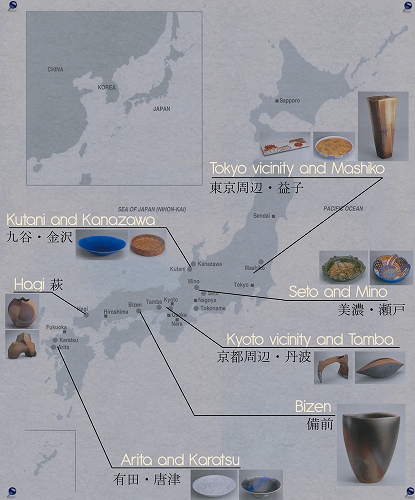Japanese Pottery: the Rising Generation from Traditional Japanese Kilns.
Shiraishi Masami
Director
Yamanashi Prefectural Museum of Art.
The ceramic arts flourish in Japan as in few other countries. Not only is this country home to an immense number of potters and ceramic artists, it also has a large population highly knowledgeable about and appreciative of pottery. Perhaps it is the distinct four seasons, the mild climate, and diverse terrain that have given Japanese a special affection for utensils made from earth or clay, a basic natural material. With this broad support base, Japanese pottery displays amazing variety. In addition to the commercial production of pottery-making for practical, daily use, individual artists pursue original work of tremendous variety. Some make mainly vessels for practical use, others combine creativity with use of traditional techniques and shapes; still others, unconcerned with practicality, seek new and experimental forms with clay. From among the works of these individual artists, we have selected for this exhibition examples of various kinds of vessels that we believe concretely illustrate thecharacter of Japanese ceramics today, suggesting their quest for something really new. These works are mostly by artists of the up-and-coming generation in the world of Japanese pottery whose work has been drawing increasing attention in recent years.
Original pottery-making tends to develop in areas where clay is locally available. The distinctive styles for which Japanese ceramics are known emerged long ago from the use of local clays, and even today, many of the traditional ceramic industry areas continue to flourish. Such areas are found especially from the Kanto region southward through Shikoku and Kyushu where porcelain clays of good quality and ample wood as fuel have been readily available. The development of kilns and the history of the craft vary from place to place, and there are some areas where pottery making has such a long history and distinctive features that many works are still created using materials, techniques, designs, and shapes that reflect those local traditions. Clay for making pottery or porcelain differs from place to place, and the temperature of firing and the expression of the works after firing are likewise distinctive. Techniques developed to utilize such features to best advantage have evolved into traditions over a long period of time. Bizen ware, for example, is a simple, unglazed ware using local, iron-rich clay. Fired without glazing, this ware features the inherent beauty of the clay. It can be identified at a glance. Bizen ware that is almost unchanged from the ceramics used for the tea ceremony during the Muromachi period (1333-1573) continues to be produced today.
Modern science has led to many advances in pottery production. New technology has had a direct effect, through improvements in firing and kiln design, and has also contributed greatly to advances in distribution and communications. Technical improvements in glazing and firing and other new ideas are quickly conveyed to people in other regions, and clays can now be easily transported from one place to another. In the past, the places where materials were available were closely related to the places where pottery was made, but now pottery can be made just about anywhere. A notable case is Oribe ware, once produced only in the Seto and Mino areas, but now made in many parts of Japan. With more sources of clay available, complex mixes are now possible, opening up further horizons in expression free from the bonds of tradition. This tendency is especially strong among artists active in and around large urban areas. The Seto/Mino region is a very old pottery producing area, but partly because of the great variety of pottery produced there on a large scale from early on, there are both potters who follow traditional techniques and many who use techniques unrelated to local tradition. This is certainly facilitated by well established infrastructure of the local ceramic industry. The same can be said of any region to some degree or other; indeed, it is a feature of Japanese pottery today.
Ceramic artists in the Greater Tokyo area are not closely linked to the local area, for this large city (once called Edo, the seat of the shogunate) was not traditionally a pottery-making area or particularly known for its clays. Rather, as the center of the nation's economy and culture for centuries, it became the location of many art schools and other art education institutions, as well as a populace who love and use pottery. The national capital is also a center of mutual stimulationamong artists and convenient for acquiring information of all sorts. It is an easy place to be a potter, and many ceramic artists and potters work in the area. Still, with the price of land exorbitant and given the various environmental constraints of an urban area, most artists maintain their bases of activity and build their own kilns in the suburbs or surrounding countryside. Tokyo based artists therefore display little in common, and they experiment with a wide variety of styles.
This exhibition introduces some of the promising artists working in traditional pottery areas under the circumstances described above who are producing notable contemporary works in the ceramic genre. Focusing on "vessels," the exhibition illustrates how artists understand the functions of a vessel in an attempt to grasp the nature of Japanese pottery today. The artists selected are among the most active in Japan. The general thrust of their production policies differs, however. Some seek to further enhance traditional techniques while working in places where pottery has been made for centuries, adding refinements in design in the effort to create even richer works of art. Others strive to free themselves from the fetters of tradition and create individualistic ceramic wares by pursuing completely new forms adapted to modern lifestyles. Still others place more emphasis on the practical aspects of pottery in contemporary life. Though different in orientation, their efforts are gradually creating a new pottery for the new age.
|
